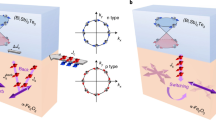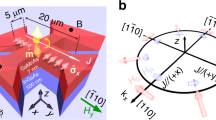Abstract
Spin–orbit torque (SOT)-induced magnetization switching shows promise for realizing ultrafast and reliable spintronics devices. Bipolar switching of the perpendicular magnetization by the SOT is achieved under an in-plane magnetic field collinear with an applied current. Typical structures studied so far comprise a nonmagnet/ferromagnet (NM/FM) bilayer, where the spin Hall effect in the NM is responsible for the switching. Here we show that an antiferromagnet/ferromagnet (AFM/FM) bilayer system also exhibits a SOT large enough to switch the magnetization of the FM. In this material system, thanks to the exchange bias of the AFM, we observe the switching in the absence of an applied field by using an antiferromagnetic PtMn and ferromagnetic Co/Ni multilayer with a perpendicular easy axis. Furthermore, tailoring the stack achieves a memristor-like behaviour where a portion of the reversed magnetization can be controlled in an analogue manner. The AFM/FM system is thus a promising building block for SOT devices as well as providing an attractive pathway towards neuromorphic computing.
This is a preview of subscription content, access via your institution
Access options
Subscribe to this journal
Receive 12 print issues and online access
$259.00 per year
only $21.58 per issue
Buy this article
- Purchase on Springer Link
- Instant access to full article PDF
Prices may be subject to local taxes which are calculated during checkout





Similar content being viewed by others
References
Miron, I. M. et al. Perpendicular switching of a single ferromagnetic layer induced by in-plane current injection. Nature 476, 189–193 (2011).
Liu, L. et al. Spin-torque switching with the giant spin Hall effect of tantalum. Science 336, 555–558 (2012).
Liu, L., Lee, O. J., Gudmundsen, T. J., Ralph, D. C. & Buhrman, R. A. Current-induced switching of perpendicularly magnetized magnetic layers using spin torque from the spin Hall effect. Phys. Rev. Lett. 109, 096602 (2012).
Pai, C.-F. et al. Spin transfer torque devices utilizing the giant spin Hall effect of tungsten. Appl. Phys. Lett. 101, 122404 (2012).
Kim, J. et al. Layer thickness dependence of the current-induced effective field vector in Ta/CoFeB/MgO. Nature Mater. 12, 240–245 (2013).
Lee, K.-S., Lee, S.-W., Min, B.-C. & Lee, K.-J. Threshold current for switching of a perpendicular magnetic layer induced by spin Hall effect. Appl. Phys. Lett. 102, 112410 (2013).
Yamanouchi, M. et al. Three terminal magnetic tunnel junction utilizing the spin Hall effect of iridium-doped copper. Appl. Phys. Lett. 102, 212408 (2013).
Garello, K. et al. Symmetry and magnitude of spin–orbit torques in ferromagnetic heterostructures. Nature Nanotech. 8, 587–593 (2013).
Zhang, C. et al. Magnetotransport measurements of current induced effective fields in Ta/CoFeB/MgO. Appl. Phys. Lett. 103, 262407 (2013).
Zhang, C. et al. Magnetization reversal induced by in-plane current in Ta/CoFeB/MgO structures with perpendicular magnetic easy axis. J. Appl. Phys. 115, 17C714 (2014).
Cubukcu, M. et al. Spin–orbit torque magnetization switching of a three-terminal perpendicular magnetic tunnel junction. Appl. Phys. Lett. 104, 042406 (2014).
Lee, K.-S., Lee, S.-W., Min, B.-C. & Lee, K.-J. Thermally activated switching of perpendicular magnet by spin–orbit spin torque. Appl. Phys. Lett. 104, 072413 (2014).
Pai, C.-F. et al. Enhancement of perpendicular magnetic anisotropy and transmission of spin-Hall-effect-induced spin currents by a Hf spacer layer in W/Hf/CoFeB/MgO layer structures. Appl. Phys. Lett. 104, 082407 (2014).
Fan, Y. et al. Magnetization switching through giant spin–orbit torque in a magnetically doped topological insulator heterostructure. Nature Mater. 13, 699–704 (2014).
Yu, G. et al. Switching of perpendicular magnetization by spin–orbit torques in the absence of external magnetic fields. Nature Nanotech. 9, 548–554 (2014).
Yu, G. et al. Current-driven perpendicular magnetization switching in Ta/CoFeB/[TaOx or MgO/TaOx] films with lateral structural asymmetry. Appl. Phys. Lett. 105, 102411 (2014).
Garello, K. et al. Ultrafast magnetization switching by spin–orbit torques. Appl. Phys. Lett. 105, 212402 (2014).
Akyol, M. et al. Current-induced spin–orbit torque switching of perpendicularly magnetized Hf/CoFeB/MgO and Hf/CoFeB/TaOx structures. Appl. Phys. Lett. 106, 162409 (2015).
Zhang, C., Fukami, S., Sato, H., Matsukura, F. & Ohno, H. Spin–orbit torque induced magnetization switching in nano-scale Ta/CoFeB/MgO. Appl. Phys. Lett. 107, 012401 (2015).
Fukami, S., Yamanouchi, M., Ikeda, S. & Ohno, H. Domain wall motion device for nonvolatile memory and logic—Size dependence of device properties. IEEE Trans. Magn. 50, 3401006 (2014).
Hoffmann, A. Spin Hall effect in metals. IEEE Trans. Magn. 49, 5172–5193 (2013).
Sinova, J., Valenzuela, S. O., Wunderlich, J., Back, C. H. & Jungwirth, T. Spin Hall effects. Rev. Mod. Phys. 87, 1213–1259 (2015).
Chen, H., Niu, Q. & MacDonald, A. H. Anomalous Hall effect arising from noncollinear antiferromagnetism. Phys. Rev. Lett. 112, 017205 (2014).
Mendes, J. B. S. et al. Large inverse spin Hall effect in the antiferromagnetic metal Ir20Mn80 . Phys. Rev. B 89, 140406 (2014).
Zhang, W. et al. Spin Hall effects in metallic antiferromagnets. Phys. Rev. Lett. 113, 196602 (2014).
Tshitoyan, Y. et al. Electrical manipulation of ferromagnetic NiFe by antiferromagnetic IrMn. Phys. Rev. B 92, 214406 (2015).
Meiklejohn, W. H. & Bean, C. P. New magnetic anisotropy. Phys. Rev. 102, 1413–1414 (1956).
Stiles, M. D. & McMichael, R. D. Model for exchange bias in polycrystalline ferromagnet–antiferromagnet bilayers. Phys. Rev. B 59, 3722–3733 (1999).
Tsunoda, M. & Takahashi, M. Field independent rotational hysteresis loss on exchange coupled polycrystalline Ni–Fe/Mn–Ir bilayers. J. Appl. Phys. 87, 6415–6417 (2000).
Chua, L. O. Memristor—the missing circuit element. IEEE Trans. Circuit Theory 18, 507–519 (1971).
Strukov, D. B., Snider, G. S., Stewart, D. R. & Williams, R. S. The missing memristor found. Nature 453, 80–83 (2008).
Jo, S. H. et al. Nanoscale memristor device as synapse in neuromorphic systems. Nano Lett. 10, 1297–1301 (2010).
Locatelli, N., Cros, V. & Grollier, J. Spin-torque building blocks. Nature Mater. 13, 11–20 (2014).
Merolla, P. A. et al. A million spiking-neuron integrated circuit with a scalable communication network and interface. Science 345, 668–673 (2014).
Suzuki, T. et al. Current-induced effective field in perpendicularly magnetized Ta/CoFeB/MgO wire. Appl. Phys. Lett. 98, 142505 (2011).
Kaplan, B. & Gehring, G. A. The domain structure in ultrathin magnetic films. J. Magn. Magn. Mater. 128, 111–116 (1993).
Acknowledgements
The authors thank C. Igarashi, T. Hirata, Y. Kawato, H. Iwanuma and K. Goto for their technical support. A portion of this work was supported by the R&D Project for ICT Key Technology to Realize Future Society of MEXT, R&D Subsidiary Program for Promotion of Academia-Industry Cooperation of METI, ImPACT Program of CSTI, and JSPS KAKENHI 15J04691.
Author information
Authors and Affiliations
Contributions
S.F. and H.O. planned the study. S.F. deposited the film. S.F. and C.Z. fabricated the samples. S.F. and A.K. performed the measurements and analysed the data. S.D. and S.F. performed the MOKE microscopy observation. S.F. wrote the manuscript with input from H.O., C.Z. and S.D. All authors discussed the results.
Corresponding authors
Ethics declarations
Competing interests
The authors declare no competing financial interests.
Supplementary information
Supplementary Information
Supplementary Information (PDF 2810 kb)
Rights and permissions
About this article
Cite this article
Fukami, S., Zhang, C., DuttaGupta, S. et al. Magnetization switching by spin–orbit torque in an antiferromagnet–ferromagnet bilayer system. Nature Mater 15, 535–541 (2016). https://doi.org/10.1038/nmat4566
Received:
Accepted:
Published:
Issue Date:
DOI: https://doi.org/10.1038/nmat4566
This article is cited by
-
Spintronic leaky-integrate-fire spiking neurons with self-reset and winner-takes-all for neuromorphic computing
Nature Communications (2023)
-
Tunable interplay between exchange coupling and uniaxial magnetic anisotropy in epitaxial CoO/Au/Fe trilayers
Scientific Reports (2023)
-
Non-volatile reconfigurable spin logic functions in a two-channel Hall bar by spin–orbit torque-based magnetic domains and directional read current
Scientific Reports (2023)
-
Multi-state data storage in a two-dimensional stripy antiferromagnet implemented by magnetoelectric effect
Nature Communications (2023)
-
Coherent antiferromagnetic spintronics
Nature Materials (2023)



